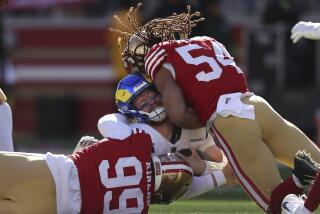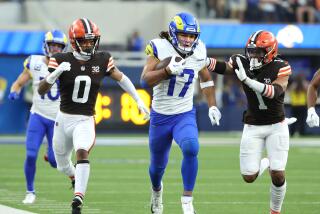Big Wheel : Two-Time RAAM Winner Forney Parlays Passion for Cycling Into Full-Time Pursuit
- Share via
IRVINE — Bob Forney is the kind of guy who thinks nothing of riding his bike from his home in Denver to Omaha and back, who once rode to the tiny town of Albany, Tex., merely to find out what the heck a “Fandangle” is, and who is seriously considering giving up ultramarathon cycling to pursue dog mushing in Alaska.
Sound as if he’s a little different?
Perhaps.
In a pursuit that seems defined by its eccentricity, Forney, 34, stands out among the crowd.
OK, so you couldn’t accurately describe the field that has gathered in Irvine for the 11th Race Across America as a crowd. But beginning today, some 50 riders of varying ability and motivation will set out on a 2,909-mile cross-country journey along the nation’s back roads to Savannah, Ga.
Forney, riding in his seventh RAAM, is trying to become the first to win the race three times. Lon Haldeman of Harvard, Ill., one of the race’s founders along with its director, John Marino, won the first two. Pete Penseyres of Fallbrook had victories in 1984 and ’86 and Susan Notorangelo of Harvard, Ill., won the women’s division in 1985 and ’89.
“If I do anything but win it’s a big disappointment,” Forney said. “I don’t have anything to gain other than a win. I think I’ve got as good a chance as anybody has had. I have the natural ability and the desire to do it. There’s no one else I’d rather be.”
It’s often difficult to imagine racing nearly 3,000 miles--across deserts and mountains, past farmland and forests, over rivers and swamps--but for the past two years Forney has done it better than anyone else. His experience, extraordinary talent and patience makes him one of the favorites, according to Marino.
“Forney is real dependable,” Marino said. “If one thing goes wrong, he’s not going to wipe out. He has a lot of staying power. Maybe he’s not so particular about things. You can bet he’s going to finish every race.”
It’s one thing to be able to ride as many as 1,600 miles during a week’s worth of training in the thin Colorado air the way Forney can. But the ability to handle the emotional ups and downs of an eight- to nine-day race is what has separated Forney from the rest of the top-notch RAAM racers the past two years.
Much of Forney’s training--physical and mental--is done along the eastern slope of the Rocky Mountains. The Denver to Trinidad, Colo., ride is one of his favorites.
“I just take the freeway down there,” he said of the almost 200-mile southbound trek on Interstate 25.
When it comes time to put in some really difficult miles, though, Forney heads to Omaha, a 1,200-mile round trip that takes about a week. Most of the time, he goes it alone, without other riders or a support van along for company. He brings only the bare essentials--money, water, food, extra clothes, tire patches and a few tools.
He admits it can get a little dull out on the road with no one to talk to, but he counters the boredom by watching the curbside litter or counting road signs. And that may explain his fascination with the “Fandangle.”
Just past the halfway point in the 1990 race, Forney and his crew noticed a sign announcing the yearly “Fandangle” in Albany, Tex., a town of 2,500 located 35 miles northeast of Abilene. Forney, on his way to victory in 8 days 11 hours 26 minutes, couldn’t take his mind off it. He knew what a fandango was, but what’s a “Fandangle?”
After a suitable recovery, Forney rode down to Albany to find out for himself. Some 600 miles later, he learned that “it’s a passion play and they put it on every summer down there.”
A seemingly endless number of miles and a change in the spelling of his last name (from Fourney to Forney) later, and he was back in Irvine ready to win his second RAAM in a row. The year before, he had spelled his name differently because he said he faced suspension by the U.S. Cycling Federation. He would not elaborate.
In RAAM ‘91, Forney took the lead for the first time in the high mountain passes of Colorado, traded it with Rob Kish of Port Orange, Fla., in Texas and Louisiana, then took over for good in Mississippi. His winning time was 8 days 16 hours 44 minutes.
So with two victories behind him, surely Forney’s got RAAM solved, right?
“It never gets easier,” he said. “Experience makes it a little easier, but sleep deprivation will play with you every year. I think the closer the race is the more I remember (the pain and exhaustion). You never really forget the feeling.
“I watched a TV special on RAAM and there was Kish one morning with wobbly legs getting on the bike. I suddenly had that RAAM feeling. It’s tough to get going some mornings.”
Forney is a relative late-comer to racing. For years, he had been content to take long, slow-paced tours with friends. The longer they rode, the stronger Forney seemed to become until he eventually outlasted the others.
It took some persuading by his friends, but Forney finally began to race in long-distance events near Denver. One thing led to another and by 1986 he was on the starting line for the fifth RAAM. Although he didn’t finish, Forney found his niche in cycling.
What started out as a tension-reliever from his job as a map maker was suddenly an obsession, and Forney has parlayed his victories in RAAM into a job as a professional cyclist. He said he makes enough money to get by, and is considering going back to work after RAAM ’92.
Win or lose, he also said, this might be his last bike race. He has, however, developed an interest in dog mushing and hopes to begin racing seriously this winter.
“I think this is going to be my last finish line,” he said. “I know I’m going to miss it. I want to quit when I’m on top.
“I’m not going to be racing USCF (U.S. Cycling Federation) age-group events. I want to go touring again. I want to go camping, not be competitive, let my guard down. I’m really looking forward to that.”
After all those miles, there’s little question that Forney is his own man. And, happily for him, there’s little that can be done to change that.
Race Across America
The Race Across AMerica (RAAM) begins in Irvine this morning and continues for 3,000 nearly nonstop miles over back roads through the continental United States, finishing in Savannah, Ga. Described as “the world’s longest time trial,” the race will require the 58 riders to rotate the pedals of their bikes about 125,000 times, at an average of 15.5 m.p.h., for up to 22 hours each day. During the race, each cyclist will drink about 50 gallons of water.
Body in Stress
Cyclist often rubs ice on eyeballs to keep them open
Neck spasms cause some cyclist wear harnesses to hold up their heads
A rider’s heart will beat about 1.5 million times
A rider’s lung will breathe about 775,000 liters of air
Knee pain develops in about 15% of the riders, but only 5% drop out of the race
A cyclist will lose about nine pounds of body fat
Team Vans
The lead van is a traveling pit stop, carrying spare parts and four extra bicycles. This crew checks the road for hazards and spies on the competition.
In the support van, a five-member crew navigates, cooks, and repairs bikes. A platform in the back of the van doubles as the cyclist’s bed and mechanic’s work table.
Outside, remote-controlled spotlights illuminate road for cyclist. A stereo system provides motivational music to keep the cyclist rolling.
Drink To Win
During the race, cyclist takes meals in liquid form. These drinks provide quick replenishment of carbohydrates, proteins, vitamins and minerals in well-balanced and easily digested 2,500-calorie dosages.
How the drinks work:
High calorie levels keep the liquid meal in stomach longer than water, but once it enters the intestines, the nutrients are quickly absorbed.
High-protein formula prevents breakdown of muscle mass.
Sucrose and glucose provide improved endurance and energy while cycling.
The Tortuous Terrain
Desert: Cyclists face dehydration, heat stroke and exhaustion. They experience sore and numb hands, feet and toes, saddle sores, rashes and boils.
Mountains: Knee ligaments and tendons begin to ache from climbing and overuse. To reduce suffering, team mechanics make a numerous bike adjustments. To block pain while cycling, riders use battery-powered electrical stimulation on injured areas.
South: Once in this portion of the race, a rider is likely to finish. But sleep deprivation causes mood swings, hallucinations and a marked loss of concentration. Support teams monitor cyclists, pulling them off bikes if exhaustion is causing reckless riding.
Sources: Lynwood Physical Therapy and Sports Rehabilitation; Ultra Marathon Cycling Association; RAAM
Researched by April Jackson / Los Angeles Times
More to Read
Sign up for The Wild
We’ll help you find the best places to hike, bike and run, as well as the perfect silent spots for meditation and yoga.
You may occasionally receive promotional content from the Los Angeles Times.






